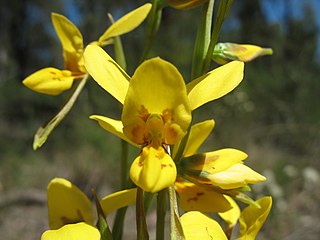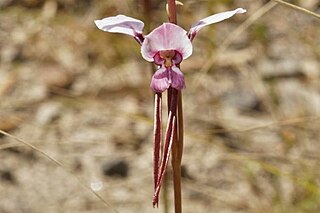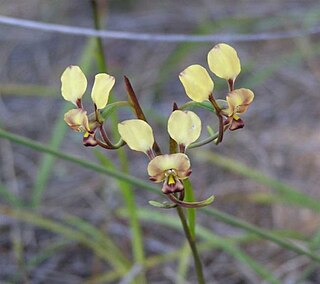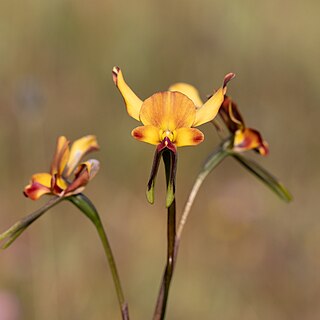
Diuris brumalis, commonly known as the winter donkey orchid, is a species of orchid that is endemic to the south-west of Western Australia. It is one of the first species of donkey orchid to flower in Western Australia each year and its flowers have been shown to attract the same insects that pollinate other species, but without offering a food reward.

Diuris aurea, commonly known as the golden donkey orchid, is a species of orchid which is endemic to Australia, growing in New South Wales and Queensland. It has one or two leaves at the base and two to five golden-yellow to orange flowers with some darker markings.

Diuris alba, commonly called the white donkey orchid, is a species of orchid which is endemic to eastern Australia. It has up to three leaves, and a flowering stem with up to seven white flowers with purplish markings.

Diuris brevifolia, commonly known as the short-leaved donkey orchid, is a species of orchid which is endemic to South Australia. It has a few narrow, twisted leaves and a flowering stem with up to five bright yellow flowers with brown markings and relatively large, spreading lobes on the labellum. This is a relatively late-flowering species of donkey orchid.

Diuris punctata, commonly known as the purple donkey orchid is a species of orchid which is endemic to south-eastern continental Australia. It has two grass-like leaves and up to ten purple or mauve flowers, often with darker, sometimes yellow marks. A yellow form from near Guyra is probably now extinct.
Diuris amplissima, commonly known as giant donkey orchid, is a species of orchid that is endemic to the south-west of Western Australia. It is a rare species and the largest Diuris in Western Australia. It has two or three leaves at its base and up to seven purple and dull yellowish-brown flowers on a tall flowering stem.

Diuris arenaria, commonly known as the Tomaree donkey orchid or sand doubletail is a species of orchid which is endemic to a very small area of New South Wales. It has two grass-like leaves and up to nine mauve or light purple and white flowers. It has a very limited distribution near Newcastle.
Diuris heberlei, commonly called Heberle's donkey orchid, is a species of orchid which is endemic to the south-west of Western Australia. It has three to five linear leaves at its base and up to four bright yellow flowers with a reddish brown border around the labellum callus. It is found along the south coast and is one of the last Diuris to flower in Western Australia.
Diuris luteola, commonly called the northern doubletail, is a species of orchid which is endemic to Queensland. It has a single linear leaf at its base and up to six pale yellow flowers with a few brown markings. It grows in shallow, stony soil on tablelands in eastern parts of the state.

Diuris oporina, commonly called the autumn donkey orchid or northern white donkeys tails is a species of orchid that is endemic to Queensland. It has a single tapering, linear leaf at its base and up to ten white flowers with mauve to purple markings. It grows in the drier parts of the tablelands in Far North Queensland.

Diuris pedunculata, commonly known as the small snake orchid, is a species of orchid which is endemic to New South Wales. It usually has two leaves at its base and one or two yellow and orange flowers with purple markings. It originally occurred in scattered populations between Tenterfield and the Hawkesbury River but because of habitat loss is now only known from the New England Tableland.

Diuris picta, commonly called the granite bee orchid or granite donkey orchid, is a species of orchid which is endemic to the south-west of Western Australia. It has between three and five leaves at its base and up to eight creamy-white to yellow flowers with brownish purple markings. It grows on granite outcrops between Menzies and Lake King.

Diuris pulchella, commonly called the beautiful donkey orchid is a species of orchid that is endemic to the south-eastern part of the south-west of Western Australia. It has two or three leaves at its base and up to five bright yellow and mauve flowers described as "exquisite", "spectacular" and "attractive". It grows in shallow soil on granite outcrops near Esperance.

Diuris recurva, commonly called the mini donkey orchid is a species of orchid that is endemic to the south-west of Western Australia. It has one or two leaves at its base, up to six small pale yellow and brownish flowers and grows in winter-wet places between Badgingarra and Kalbarri.
Diuris secundiflora, commonly known as the one-sided donkey orchid, is a poorly-known species of orchid that is endemic to New South Wales. It has a single grass-like leaf and up to eight yellow flowers that are sometimes spotted and are all arranged on one side of the flowering stem.

Diuris semilunulata, commonly known as the late leopard orchid, is a species of orchid that is endemic to New South Wales and the Australian Capital Territory. It has two grass-like leaves and up to five orange-coloured flowers with brown and purple blotches.

Diuris setacea, commonly called the bristly donkey orchid, is a species of orchid that is endemic to the south-west of Western Australia. It has a tuft of up to ten twisted leaves at its base and up to seven yellow flowers with a few brown markings. It grows in moist soil on granite outcrops and flowers much more prolifically after fire the previous summer.

Diuris tricolor, commonly known as the long-tailed donkey orchid or pine donkey orchid, is a species of orchid that is endemic to eastern Australia. It has up to three grass-like leaves and up to six orange-coloured to yellow flowers with white and purplish tints. The lateral sepals are unusually long.
Diuris unica is a species of orchid which is endemic to eastern Australia. It usually has only one grass-like leaf at its base and up to eight bright, lemon-yellow flowers with a few dark markings. It is similar to D. chrysantha but flowers much earlier than that species and has only a single leaf rather than two.

Diuris brachyscapa, commonly known as western wheatbelt donkey orchid, is a species of orchid that is endemic to the south-west of Western Australia. It has two or three linear leaves and a flowering stem with up to four pale yellow flowers with brown markings.















